
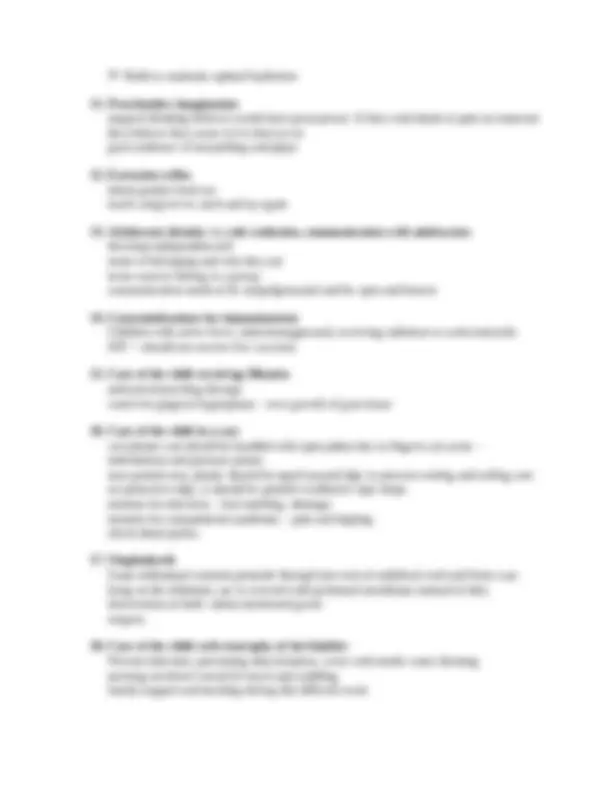
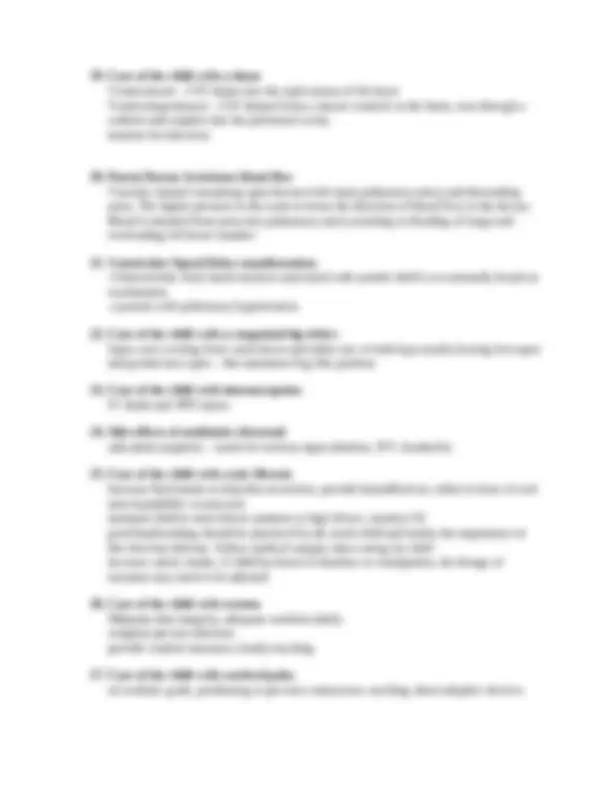
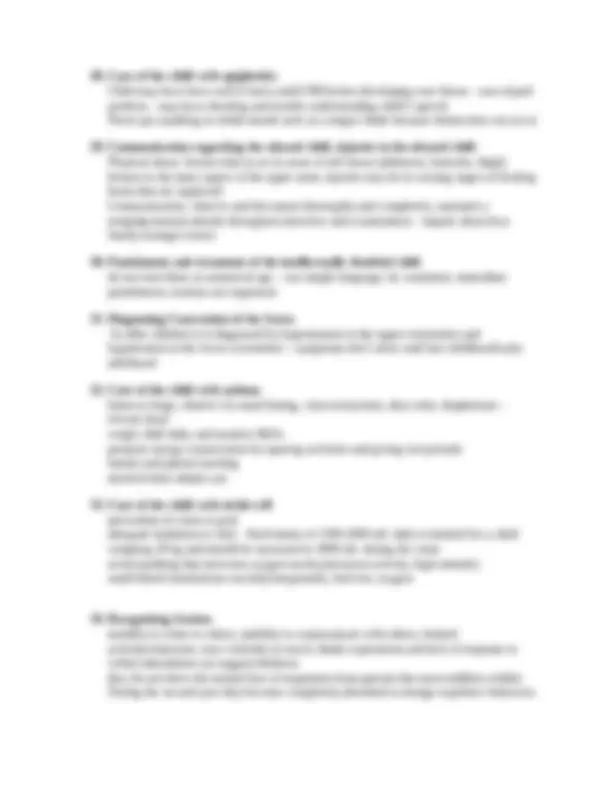
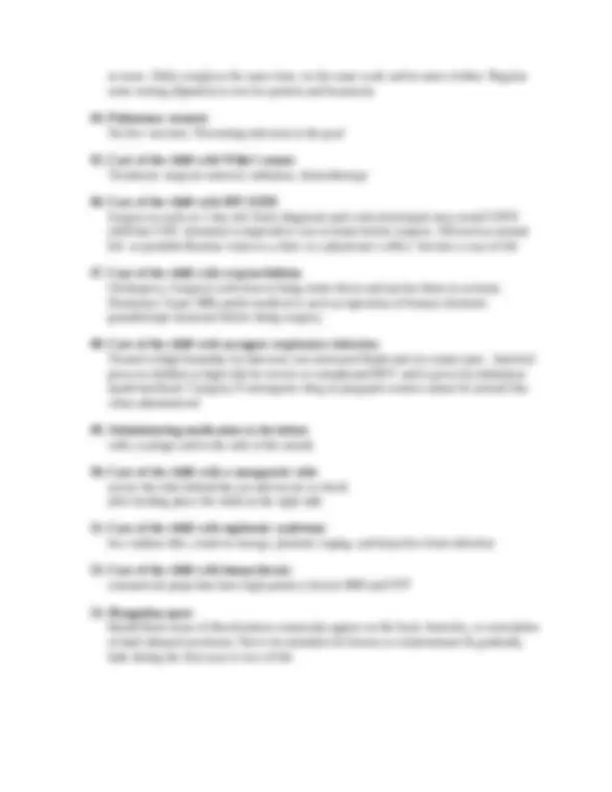
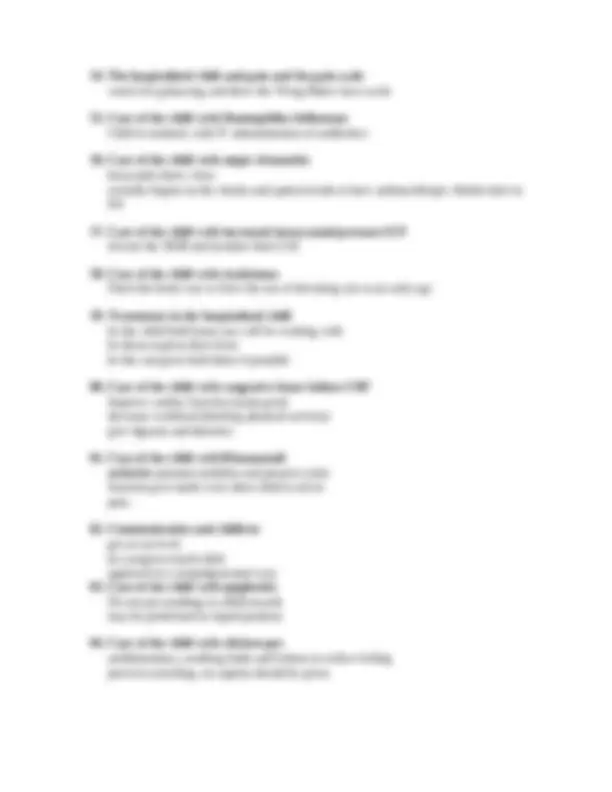



Study with the several resources on Docsity

Earn points by helping other students or get them with a premium plan


Prepare for your exams
Study with the several resources on Docsity

Earn points to download
Earn points by helping other students or get them with a premium plan
Community
Ask the community for help and clear up your study doubts
Discover the best universities in your country according to Docsity users
Free resources
Download our free guides on studying techniques, anxiety management strategies, and thesis advice from Docsity tutors
Peds Final Review-PEDIATRIC FINAL EXAM REVIEW GUIDE.Peds Final Review-PEDIATRIC FINAL EXAM REVIEW GUIDE.
Typology: Exams
1 / 10

This page cannot be seen from the preview
Don't miss anything!







1. Growth pattern Cephalocaudal: start at head and moving downward proximodistal: start at center and progress outward not uniform “growth spurts” are periods of rapid growth 2. Care of the hospitalized toddler, growth of the toddler, characteristics and appearance of the toddler “me do it” – stubborn, explorer 5-10 lbs, ~3 inches each year discipline, pick up child and carry him/her to a quiet neutral place to regain control consistency and timing are important parallel play hospital – include caregiver in care – frightening for toddler – no concept of time “caregiver will be back at lunch” 3. Care of the child with seizures safety is the highest priority during seizures. Teach family how to prevent injury during seizure. Pad side rails in hopsitals. Move furniture/objects that could cause injury. Go for help when seizure begins. Place child on side with head turned to one side. Document time seizure started, any factor present just prior to (bright lights/noises), eye position and movement, incontinence of urine or stool. Suction at bedside. 4. Care of the child in traction skeletal traction requires meticulous pin site care any sign of infection (odor, local edema, increased temp) must be documented and reported at once external fixation devices can be left in place for as long as a year so body image can be an issue and help the child to accept 5. Care of the child following tonsillectomy Immediately after surgery place in partially prone position with head turned to one side until completely away. Discourage coughing Check VS every 15 minutes until fully away and then check every 30 min to 1 hour bleeding is most often a concern within the first 24 hours after surgery and the 5 th-7th^ day post op during fist 24 hours observe, document and report any unusual restlessness or anxiety, frequent swallowing or rapid pulse that may indicate bleeding ice collar can be used if child is comfortable with it
6. Care of the child with a cleft lip/palate insert gloved finger into newborns mouth to feel if palate is intact higher than normal risk of aspiration maintaining adequate nutrition, keep in a upright position, use special nipples, take time if cleft lip unilateral direct at unaffected side, don’t tire baby care of lip suture line – carefully clean sutures after feeding and as often as necessary to prevent collection of dried formula or serum and use sterile water. Gently clean with sterile cotton swabs 7. Care of the child with burns emergency treatment – cool water; NO ICE airway-inhalation injury intraveneous fluids-hypovolemic shock major concern 1 st^ 24-48 hours as extracellular fluid pours into burned area-dehydrates body oral fluids-avoided or omitted first couple days NG tube may be needed need Vitamin C/E/A/Zinc for tissue healing urine output-monitor closely. Diuretic phase occurs after 1 st^24 hours d/t initial fluid therapy brings shock under control and compensates for extracellular fluid deficit infection risk. Reverse isolation wound care-open/closed method (left open to air/covered); daily debridement and hydrotherapy; very painful for child so medicate; teach that care must be done even though painful 8. Care of the child with Spina Bifida surgery is required to close the open defect but may not be done immediately until surgery is performed, sac must be covered with a sterile dressing moistened in a warm sterile solution (often saline). Change every 2 hours and do not allow to dry maintain newborn in prone position so that no pressure is placed on the sac encourage family to cuddle and/or touch newborn. With permission of MD, newborn may be helf in a chest-to-chest position to provide closer contact 9. Care of the child with congenital hypothyroidism thyroid hormone must be relaced as soon as the diagnosis is made and continued for life (levothyroxine) 10. Care of the child with a tracheoesophageal fistula TEF frothing, excessive drooling and periods of respiratory distress with choking an cyanosis no feeding should take place until the newborn has been examined. If feeding is attempted, the newborn chokes, coughs, and regurgitates as the food enters the blind pouch careful nursing observation for early diagnosis in imperative surgical intervention is necessary to correct the defect
19. Care of the child with a shunt Ventriculoatri – CSF drains into the right atrium of the heart Ventriculoperitoneal – CSF drained from a lateral ventricle in the brain, runs through a catheter and empties into the peritoneal cavity monitor for infection 20. Patent Ductus Arteriosus blood flow Vascular channel remaining open between left main pulmonary artery and descending aorta. The higher pressure in the aorta reverses the direction of blood flow in the ductus. Blood is shunted from aorta into pulmonary artery resulting in flooding of lungs and overloading left heart chamber 21. Ventricular Septal Defect manifestations - Characteristic loud, harsh murmur associated with systolic thrill is occasionally heard on examination -cyanosis with pulmonary hypertension 22. Care of the child with a congenital hip defect Spica cast covering from waist down and either one or both legs usually leaving feet open and genital area open – this maintains frog like position 23. Care of the child with intussusception IV fluids and NPO status 24. Side effects of antibiotics discussed salicylates (aspirin) – watch for toxicity signs (tinnitus, N/V, headache) 25. Care of the child with cystic fibrosis Increase fluid intake to help thin secretions, provide humidified air, either in form of cool mist humidififer or mist tent maintain child in semi-folwer position or high folwer, monitor O good handwashing should be practiced by all; teach child and family the importance of this first line defense. Follow medical asepsis when caring for child increase caloric intake, if child has bouts of diarrhea or constipation, the dosage of enzymes may need to be adjested 26. Care of the child with eczema Maintain skin integrity, adequate nutrition (daily weights) prevent infection provide comfort measures, family teaching 27. Care of the child with cerebral palsy set realistic goals, positioning to prevent contractures, teaching about adaptive devices
28. Care of the child with epiglottitis Child may have been well or had a mild URI before developing sore throat – uses tripod position – may have drooling and trouble understanding child’s speech Never put anything in childs mouth such as a tongue blade because obstruction can occur 29. Communication regarding the abused child, injuries in the abused child Physical abuse: bruises that occur in areas of soft tissue (abdomen, buttocks, thigh) bruises in the inner aspect of the upper arms, injuries may be in varying stages of healing burns that are neglected Communication: observe and document thoroughly and completely, maintain a nonjudgemental attitude throughout interview and examination – inquire about how family manages issues 30. Punishment and treatment of the intellectually disabled child do not treat them as numerical age – use simple language, be consistent, immediate punishment, routines are important 31. Diagnosing Coarctation of the Aorta In older children it is diagnosed by hypertension in the upper extremities and hypotension in the lower extremities – symptoms don’t arise until late childhood/early adulthood 32. Care of the child with asthma listen to lungs, observe for nasal flaring, chest retractions, skin color, diaphoresis – elevate head weigh child daily and monitor I&Os promote energy conservation by spacing activities and giving rest periods family and patient teaching metered dose inhaler use 33. Care of the child with sickle cell prevention of crises is goal adequate hydration is vital – fluid intake of 1500-2000 mL daily is desired for a child weighing 20 kg and should be increased to 3000 mL during the crisis avoid anything that increases oxygen needs (strenuous activity, high attitude) small blood transfusions can help temporarily, bed rest, oxygen 34. Recognizing Autism inability to relate to others, inability to communicate with others, limited activities/interests, react violently to touch, blank expressions and lack of response to verbal stimulation can suggest deafness they do not show the normal fear of separation from parents that most toddlers exhibit. During the second year they become completely absorbed in strange repetitive behaviors
growth and development-encourage family to help child return to normal activities as much as possible during the treatment’s maintenance phase when the child has been discharged from hospital.Promoting a positive body image-encourage family to choose wig before child’s hair falls out so that the color can be matched. A scarf or cap may be preferred by child. Reassure that hair will grow back.Promoting family coping- provide opportunity for expression of feelings, refer to support group and American Childhood Cancer Organization
40. Care of the child with diabetes Teach family to treat BS levels less than 60 mg/dL w/juice, sugar, non-diet soda and then a simple carb. Reaction should be followed by complex carb such as crackers, and a protein such as cheese, peanut butter, or half of a meat sandwich in order to maintain the increase in BS created by simple carb.When illness occurs the insulin needs increase r/t metabolic rate increase and body needs more sugar therefore more insulin to make sugar available to body. Check BS Q2H during this time and never skip insulin. Increase fluids and report vomiting, diarrhea or inability to eat.Reassure caregiver and child that hypoglycemia is more likely to occur than hyperglycemia. If there is any doubt as to whether the child is having a hypoglycemic or hyperglycemic reaction, treat it like hypoglycemia.Teach to inject insulin at 90 degree angle.When unstable eating habits occur a fast acting insulin should be used. 41. Care of the child with failure to thrive FTT Multidisciplinary; initially almost entirely dependent upon good nursing care: family teaching; support. By teaching childcare skills, acting as a role model, and supporting caregiver-child interactions, you can help reverse the child’s growth failure and begin an improved caregiver-child relationship.High priority-Teach and support caregiver 42. Care of the child with rheumatic fever Prevention of residual heart disease. Bed rest is ordered and length is determined by degree of carditis present and is essential to reduce the workload of the heart. Treated much like CHF as well diuretics etc. Salicylates are given in the form of acetylsalicylic acid (aspirin) to children w/daily dosage calculated according to weight. Aspirin relieves pain and reduces inflammation of polyarthritis. Watch for toxicity signs (tinnitus, N/V, headache).Providing comfort measures, reducing pain-position child to relieve pain, warm baths and gentle ROM exercises.Be aware that even the weight of covers may cause pain.Provide diversional activities and promote energy conservation.Can recur w/strep infection-must take prophylactic doses of penicillin for 5 years or longer. When having dental work or oral surgery extra prophylactic precautions must be taken even into adulthood 43. Care of the child with Acute glomerulonephritis Limit activities for 2-4 weeks after onset.Penicillin (to eradicate existing infection). Bed rest until acute symptoms and acute hematuria disappear.Strict I&O.Follow fluid restriction parameters. Blood pressure should be monitored regularly and diuretic may be given to reduce BP and antihypertensive may be given is diastolic pressure is 90 mmHg
or more. Daily weight at the same time, on the same scale and in same clothes. Regular urine testing (dipstick) to test for protein and hematuria
44. Pulmonary stenosis No live vaccines. Preventing infection is the goal 45. Care of the child with Wilm’s tumor Treatment: surgical removal, radiation, chemotherapy 46. Care of the child with HIV/AIDS Surgery as early as 1 day old. Early diagnosis and correction/repair may avoid CHFIf child has CHF, treatment is imperative care at home before surgery: Allowed as normal life as possible.Routine visits to a clinic or a physician’s office become a way of life 47. Care of the child with cryptorchidism Orchiopexy: Surgical correction to bring testes down and anchor them in scrotum. Hormones: Some MDs prefer medical tx such as injections of human chorionic gonadotropic hormone before doing surgery. 48. Care of the child with an upper respiratory infection Treated w/high humidity by mist tent, rest increased fluids and on contact prec. Antiviral given to children at high risk for severe or complicated RSV and is given by inhalation mask/tent/hood. Category X teratogenic drug so pregnant women cannot be around this when administered 49. Administering medication to the infant with a syringe and to the side of the mouth 50. Care of the child with a nasogastric tube secure the tube behind the ear and secure to cheek after feeding place the child on the right side 51. Care of the child with nephrotic syndrome low sodium diet, conserve energy, promote coping, and keep free from infection 52. Care of the child with hemarthrosis commercial preps that have high potency factors 8&9 and FFP 53. Mongolian spots bluish black areas of discoloration commonly appear on the back, buttocks, or extremities of dark skinned newborns. Not to be mistaken for bruises or mistreatment & gradually fade during the first year or two of life